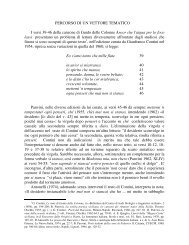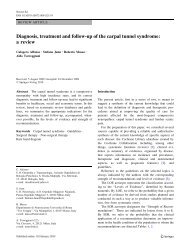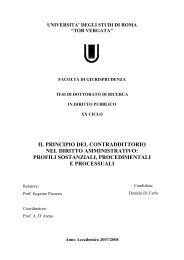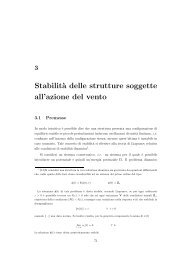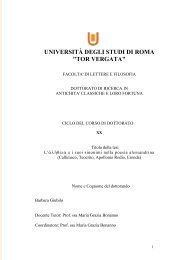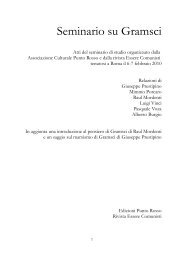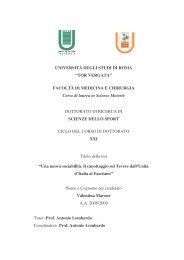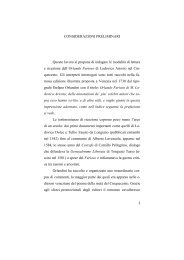Universitā degli studi di Roma “Tor Vergata” - ART - TORVERGATA ...
Universitā degli studi di Roma “Tor Vergata” - ART - TORVERGATA ...
Universitā degli studi di Roma “Tor Vergata” - ART - TORVERGATA ...
You also want an ePaper? Increase the reach of your titles
YUMPU automatically turns print PDFs into web optimized ePapers that Google loves.
where Ix is the advective flux in x <strong>di</strong>rection [g m -2 s -1 ]; ux is the average longitu<strong>di</strong>nal velocity [m<br />
s -1 ]; c is the tracer concentration [g m -3 ]. The Lagrangian system, which lies at the centre of the<br />
tracer cloud (collection of fluid parcels whose <strong>di</strong>mension are comparable with the smallest length<br />
scale of interest and with velocity and concentration characteristics), is use for advection.<br />
The molecular <strong>di</strong>ffusion is modelled by the Fick’s law:<br />
∂c<br />
J x = −em<br />
∂x<br />
Eq. 2.2-6<br />
where Jx is the molecular <strong>di</strong>ffusive flux in the x <strong>di</strong>rection [g m -2 s -1 ]; em is the molecular <strong>di</strong>ffusion<br />
coefficient whose typical value in water changes between 0.5 – 2.0 x 10 -9 [m 2 s -1 ]; δc/δx is the<br />
tracer concentration gra<strong>di</strong>ent in the x <strong>di</strong>rection [g m -4 ]. The negative sign means that the<br />
molecular <strong>di</strong>ffusion develops in the opposite <strong>di</strong>rection of the concentration gra<strong>di</strong>ent. The<br />
molecular <strong>di</strong>ffusion is defined in a fixed Eulerian coor<strong>di</strong>nates.<br />
The advection/<strong>di</strong>ffusion three <strong>di</strong>mensional equation can be derived from a mass balance<br />
on a rectangular parcel fluid moving at mean velocity is in rectangular Cartesian coor<strong>di</strong>nates 2 :<br />
∂c<br />
+<br />
∂t<br />
3<br />
∑<br />
⎛ ∂c<br />
⎞ ⎡<br />
⎜<br />
⎜u<br />
⎟ i = em<br />
⎢<br />
⎝ ∂x<br />
⎠ ⎣<br />
∑<br />
2 ⎛ ∂ c ⎞⎤<br />
⎜<br />
⎟ 2 ⎥<br />
⎝ ∂x<br />
⎠⎦<br />
i= 1 i<br />
i= 1 i<br />
3<br />
Eq. 2.2-7<br />
where ui is the average velocity along the three orthogonal <strong>di</strong>rections defined by the rectangular<br />
Cartesian coor<strong>di</strong>nates [m s -1 ] where 1=“x”, 2=”y” and 3=”z”.<br />
A solution of this system for:<br />
a. a conservative tracer;<br />
b. known initial con<strong>di</strong>tions;<br />
c. stationary situation;<br />
d. unbounded channel;<br />
allows us seeing that the variance of tracer cloud increase linearly with time.<br />
If the Reynolds number is below 500 the flow is laminar, if it is above about 2000 the<br />
flow is turbulent which is generated by velocity shears where there are velocity gra<strong>di</strong>ents. In a<br />
turbulent flow the tracer spread more rapidly than in the first one.<br />
2 It is considered the right Cartesian coor<strong>di</strong>nate system.<br />
41



